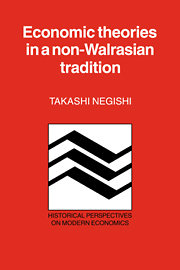Book contents
- Frontmatter
- Contents
- Preface
- 1 Anti-neoclassical or non-Walrasian economic theories
- Part I Increasing returns and diminishing cost
- Part II Wages and profit
- 6 Conditions for the wages fund doctrine and Mill's recantation of it
- 7 Marx and exploitations in production and in circulation
- 8 Marx's dichotomy between exploitation and redistribution of surplus products
- 9 Böhm-Bawerk and the positive rate of interest in a stationary state
- Part III International trade and investment
- Part IV Markets and money
- Notes
- References
- Author index
- Subject index
7 - Marx and exploitations in production and in circulation
from Part II - Wages and profit
Published online by Cambridge University Press: 21 September 2009
- Frontmatter
- Contents
- Preface
- 1 Anti-neoclassical or non-Walrasian economic theories
- Part I Increasing returns and diminishing cost
- Part II Wages and profit
- 6 Conditions for the wages fund doctrine and Mill's recantation of it
- 7 Marx and exploitations in production and in circulation
- 8 Marx's dichotomy between exploitation and redistribution of surplus products
- 9 Böhm-Bawerk and the positive rate of interest in a stationary state
- Part III International trade and investment
- Part IV Markets and money
- Notes
- References
- Author index
- Subject index
Summary
Ricardo defined the principal problem in political economy as the determination of the laws that regulate distribution (Ricardo 1951, p. 5). It is no wonder, therefore, that the key concept in Marx's Das Kapital is also the law of distribution, since “Marx used the Ricardian apparatus: he adopted Ricardo's conceptual layout and his problems presented themselves to him in the forms that Ricardo had given to them” (Schumpeter 1954, p. 390). In volume I of Das Kapital Marx analyzed the problem of distribution between the exploiting class in general and the exploited class, laborers, by the use of labor theory of value, while the redistribution among exploiters is considered in volume III of the same book. I examine critically Marx's treatment of the former problem in this chapter, and consider the latter problem and its relation to the former in the next chapter.
The crux of Marxist labor theory of value is to explain how and why surplus value or profit is created and exploited, not in circulation, but in production, even if commodities are exchanged according to their values. It should be criticized, therefore, not so much from the point of view of the theory of relative prices as from the point of view of the theory of profit. This is why Böhm-Bawerk's famous criticism of Marx in his Karl Marx and the close of his system was rather pointless while more important is his criticism against exploitation theory of interest in his Capital and interest.
- Type
- Chapter
- Information
- Economic Theories in a Non-Walrasian Tradition , pp. 72 - 88Publisher: Cambridge University PressPrint publication year: 1985

